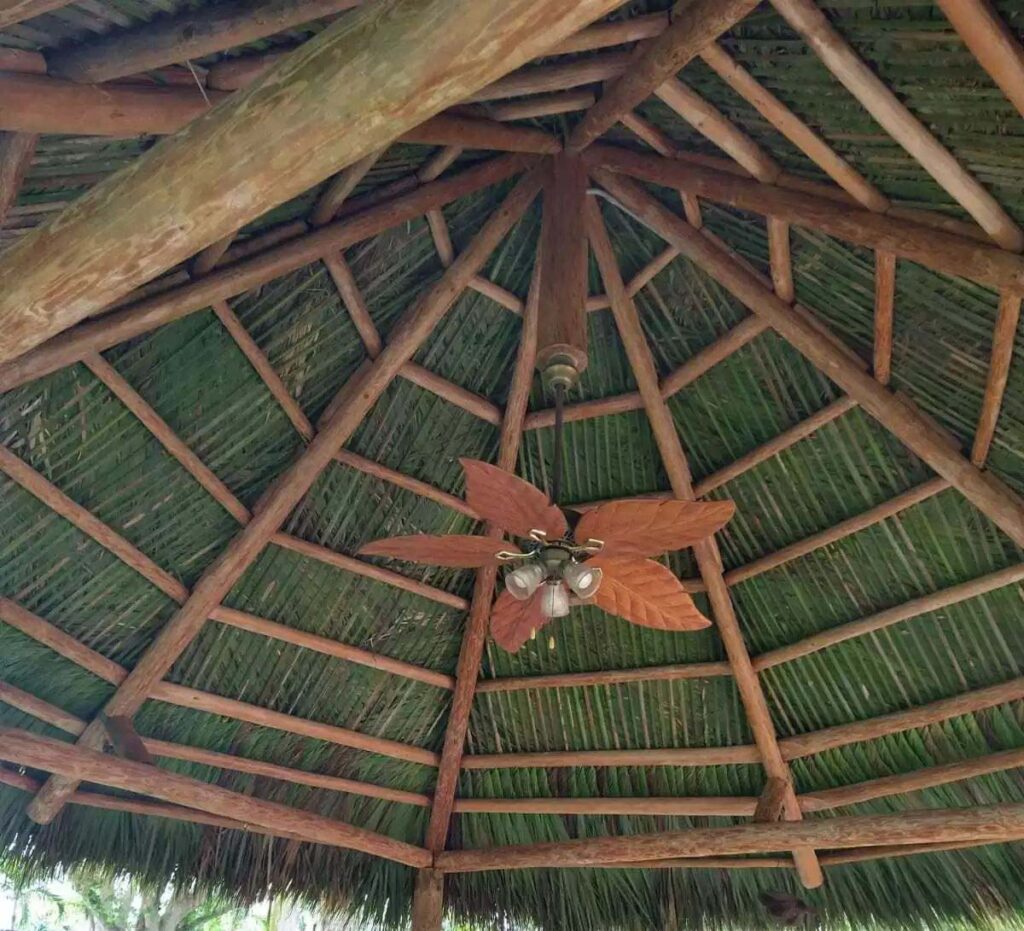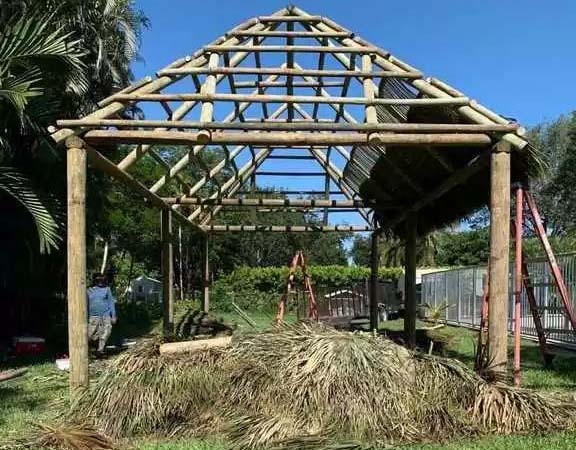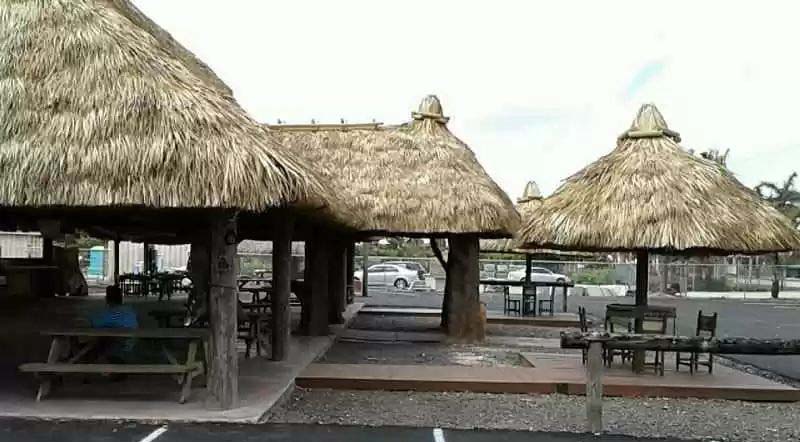How long does a thatched roof last? Thatched roofs are beautiful and unique but require care to stay durable. Without proper maintenance, they may wear down quickly, leading to leaks or structural issues. However, with regular upkeep, you can enjoy your thatched roof for decades.
This guide will explain everything you need to know about thatched roof longevity. From the factors affecting its lifespan to actionable maintenance tips, you’ll learn how to protect your investment and make your roof last.
What Impacts the Lifespan of a Thatched Roof?
Key Factors That Influence Thatch Roof Longevity
Thatch roof longevity depends on multiple factors, including materials, environmental conditions, and maintenance routines. On average, a well-maintained thatched roof can last 20–30 years. However, not all thatch materials are created equal.
- Material Quality: Palm thatch, often used for Tiki huts, may require more frequent care compared to synthetic or reed thatch.
- Climate: Humid environments like Florida accelerate wear and tear on thatch due to moisture and mold growth.
- Roof Design: The angle of the roof impacts water drainage. Steeper roofs tend to last longer as they prevent water pooling.
- Usage: Roofs exposed to heavy foot traffic or frequent use may wear faster.
Knowing these factors can help you better care for your roof. Proactive maintenance is the key to extending its life.
The Importance of Rethatch Cycles
Rethatching is an integral part of maintaining a thatched roof. Over time, the natural materials in the thatch begin to break down, requiring replacement. For palm thatch roofs, rethatching is typically needed every 5–7 years, while other materials like reed may last up to 15 years before requiring a refresh.
Signs your roof needs rethatching include:
- Visible gaps or thinning in the thatch.
- Increased leaks or water penetration during rain.
- A worn or uneven appearance.
Ignoring rethatch cycles can lead to costly structural repairs. By scheduling rethatching at the right intervals, you can ensure your roof remains functional and attractive.

Maintaining Palm Thatch for Long-Term Use
Palm thatch is widely used for its aesthetic appeal but demands consistent care. To maintain it effectively:
- Clean Regularly: Remove debris like leaves and branches that can trap moisture and lead to mold growth.
- Promote Ventilation: Proper airflow prevents the thatch from becoming damp, reducing the risk of rot.
- Use a Weatherproof Coating: Applying a protective layer shields the thatch from rain and sun damage.
- Inspect for Pests: Termites and other insects can harm the thatch. Treat the roof with natural or professional pest deterrents.
By taking these steps, you can preserve the natural beauty of palm thatch and extend its longevity.

Best Practices for Caring for a Thatched Roof in Florida
Tips for Thatched Roof Maintenance in Florida’s Climate
Florida’s weather is known for its extremes, from intense UV exposure to heavy storms. These conditions can cause thatch to degrade faster. To combat this, adopt a maintenance routine tailored to Florida’s climate:
- UV Protection: Apply a UV-resistant spray to prevent the sun from drying out the thatch.
- Rainproofing: Ensure the roof is treated with waterproofing agents to minimize water absorption during rainstorms.
- Hurricane Prep: Before hurricane season, inspect the roof for loose or damaged thatch and secure any weak spots.
In addition, consider professional inspections twice a year to address hidden issues before they worsen.
The Process and Benefits of Tiki Hut Rethatching
Tiki huts are iconic in Florida but require regular rethatching to maintain their charm and functionality. The process of rethatching involves:
- Removing the old thatch layers.
- Inspecting and repairing the roof’s structure.
- Installing fresh thatch material in secure layers.
Rethatching enhances the hut’s appearance, ensures better waterproofing, and prevents structural damage. While DIY rethatching is an option, hiring professionals guarantees a polished result and a longer-lasting performance. The investment pays off by significantly extending your hut’s lifespan.
Unique Considerations for Homestead Roof Care
Thatch Roof Care in Homestead: What Makes It Different?
Homestead, Florida, presents unique challenges for thatched roof owners. Proximity to the coast means salt air can corrode natural materials faster. Additionally, tropical storms frequently test the roof’s durability.
Here are location-specific tips for roof care:
- Pre-Storm Preparations: Inspect and reinforce the roof before storm season to minimize potential damage.
- Salt Air Protection: Apply treatments designed to protect against salt-related wear.
- Frequent Cleaning: In areas with heavy tree coverage, clear fallen leaves regularly to prevent moisture buildup.
These extra precautions ensure your thatched roof thrives in Homestead’s challenging environment.
Preventing Leaks in Your Thatch Roof
Leaks are one of the most common issues for thatched roofs, especially in rainy climates. To prevent them:
- Inspect the roof regularly for loose or displaced thatch.
- Seal small gaps with waterproof materials before they grow into bigger problems.
- Ensure proper drainage around the roof to avoid water pooling near its base.
Waterproofing products specifically designed for thatched roofs can add an extra layer of protection. These strategies will help you avoid costly repairs and prolong your roof’s life.

Repairing a Damaged Thatched Roof to Extend Its Lifespan
Expert Tips for Thatch Roof Repair
Thatch roof repair is essential when wear or damage goes beyond basic maintenance. Common repairs include:
- Replacing sections of damaged or missing thatch.
- Fixing leaks or sealing gaps to prevent water infiltration.
- Reinforcing the roof’s framework if structural issues are found.
When is it time to repair? Look for signs like sagging areas, frequent leaks, or visible gaps in the thatch. Hiring experienced professionals ensures the repairs are done correctly, preserving the roof’s structural integrity and appearance.
Maximizing the Lifespan of Your Thatched Roof
To ensure your thatched roof lasts as long as possible, follow these final tips:
- Stick to Regular Maintenance: Routine cleaning, inspections, and protective treatments are your first line of defense.
- Don’t Skip Rethatching: Replace old thatch before it becomes a problem.
- Act Quickly on Repairs: Address minor issues before they escalate into costly repairs.
- Work with Professionals: From rethatching to structural repairs, professionals have the tools and expertise to keep your roof in top shape.
Protect Your Investment and Ensure Longevity
How long does a thatched roof last? With proper care, it can last decades. By maintaining palm thatch, scheduling rethatch cycles, and addressing repairs promptly, you’ll enjoy a durable and beautiful roof for years to come.
If you’re ready to maximize your roof’s lifespan, call us today at (786) 255-6529 for expert maintenance, rethatching, and repairs! Let us help you keep your roof strong and stunning for years to come.

